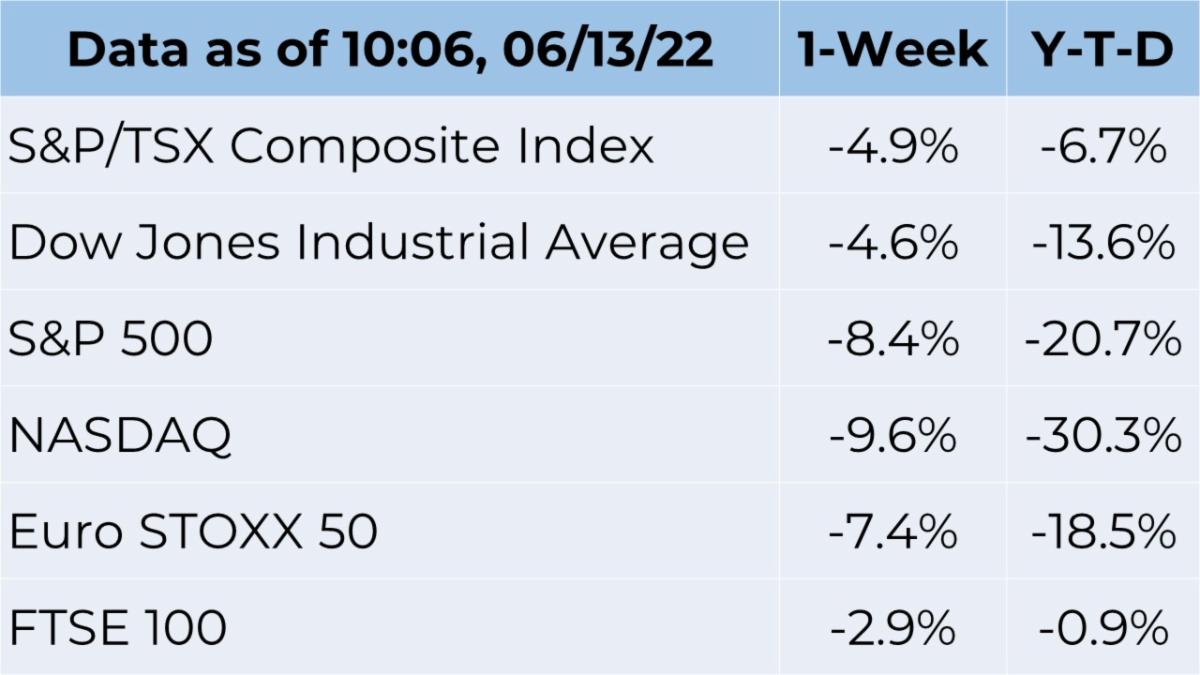Weekly Market Commentary June 16th, 2022
The Markets
Inflation is proving to be far more tenacious than markets had anticipated.
The idea that inflation peaked in March was put to rest last week when the Consumer Price Index (CPI) showed that inflation accelerated in May. Overall, data from south of the border showed that prices were up 8.6 per cent last month, an increase from April’s 8.3 per cent (Statistics Canada has not yet released May inflation data). It was the highest inflation reading we’ve seen since December 1981.
The most significant price increases were in energy (+34.6%) and food (+10.1%). The Biden administration attributes these increases to the ongoing conflict in eastern Ukraine, but the situation is not that simple nor that recent; inflation has been trending higher since before the recent escalation of tensions in the near decade-long conflict; shortages and supply chain issues caused by the situation in Eastern Europe have been exacerbating existing problems associated with Washington’s policies. Those problems include cancelling the Keystone XL pipeline, not approving any new drilling operations and unchecked spending funded by printing record amounts of money.
At the same time, China has been creating additional stress on their own economy and global supply chains by pursuing a “zero-COVID policy”, where major metropolitan centres with millions of residents have faced strict lockdowns because of a handful of coronavirus cases.
With inflation rising, central banks will likely continue to aggressively raise rates. There is a 50-50 chance the Fed will raise rates by 0.75 per cent in July (rather than 0.50 per cent). Some economists say there could be a 0.75 per cent hike this week when the Fed meets, reported Scott Lanman and Kristin Aquino of Bloomberg. The Bank of Canada has also been raising rates in an attempt to combat our own rising inflation, and will likely continue to move in the same direction as the Fed.
The inflation news unsettled already volatile stock and bond markets. Major North American stock indices declined last week. The yield curve flattened a bit as the yield on two-year Treasuries and Government of Canada bonds rose to multi-year highs, closing the gap between two-year and ten-year bonds, with the two-year Government of Canada bonds closing the week trailing ten-year bond yields by only 0.1 per cent.
If you have any questions or concerns about your investment portfolio or recent market events, please don’t hesitate to give us a call.

Source: FactSet
Recent Videos:




Coping with a bear market is not easy
A bear market occurs when stocks have declined in value by about 20 per cent or more. Investing during a bear market can be a lot like playing baseball for a team that’s in a slump. Your teammates are worried, hecklers distract the players’ attention, and the team’s record of wins and losses moves in the wrong direction. You might find yourself beginning to question whether playing baseball is right for you.
Before you decide to exit the game, here are some tips for coping with bear markets:
1. Remember, downturns don’t last forever. The S&P 500 index has experienced seven bear markets over the last 50 years and recovered from all of them, reported Thomas Franck of CNBC. Here’s a rundown of the duration and returns of bear and bull markets since 1973.
Year Bear market Total return Bull market Total return
1973 21 months -48 per cent 74 months +126 per cent
1980 20 months -27 per cent 60 months +229 per cent
1987 3 months -34 per cent 31 months + 65 per cent
1990 3 months -20 per cent 113 months +417 per cent
2000 31 months -49 per cent 60 months +102 per cent
2007 7 months -57 per cent 131 months +401 per cent
2020 1 month -27 per cent TBD TBD
“Bull markets tend to last far longer and generate moves of far greater magnitude than bear markets. Time after time, bear markets have proven to be good buying opportunities for long-term investors,” explained Thomas Franck of CNBC. Remember, however, that past performance does not guarantee future results.
2. Stay diversified. Make sure your portfolio remains well diversified. During bear markets, some segments of the market will outperform while others underperform. A diversified portfolio can provide a cushion. Diversification won’t help you avoid a loss, but it can help minimize it.
3. Talk with us. During market downturns, investors often panic. That causes some to sell investments and incur losses that may be difficult to recover. If you’re tempted to sell, give us a call first. We’ll discuss your concerns, review your portfolio and help you decide on a course of action.
Possibly the most important things you can do during a bear market are to stay calm and resist making any sudden moves.
Weekly Focus - Think About It
“You get recessions, you have stock market declines. If you don't understand that's going to happen, then you're not ready, you won't do well in the markets.”
—Peter Lynch, former portfolio manager
Best regards,
Eric Muir
B.Comm. (Hons.), CIM®, FCSI
Portfolio Manager
Tracey McDonald
FCSI, DMS, CIM®
Portfolio Manager
Derek Lacroix
BBA, CIM®, CFP®
Associate Financial Advisor

